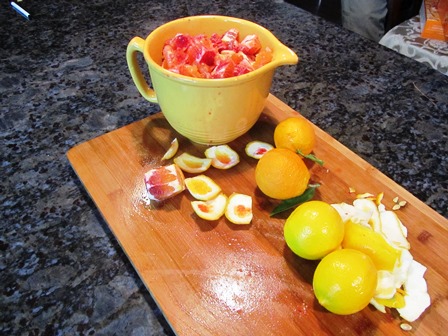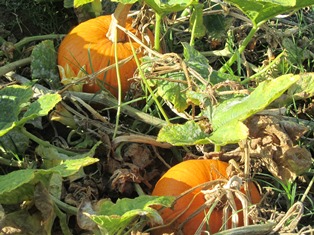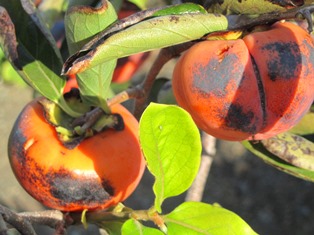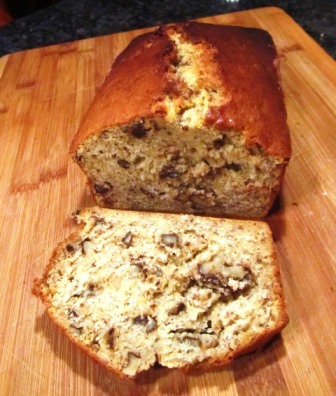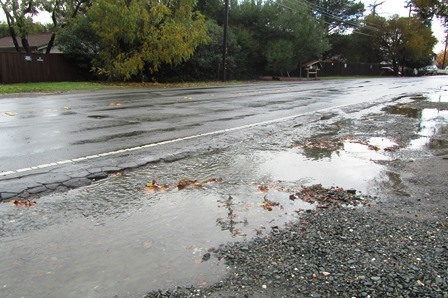Archive for December, 2014
How to Make Marmalade from Blood Oranges
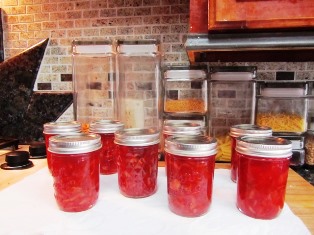
Jars of freshly made blood-orange marmalade are a festive red currant color and perfect for holiday gift-giving
On Christmas Eve this year, I made marmalade from our blood oranges to tuck into our holiday gift baskets.
Our citrus trees are still young and the crop, though ripe, was not yet bountiful. I used almost our entire crop of 20 oranges to make 8 jars (4 ounces each) of the blood orange marmalade.
My recipe is straightforward and the steps are simple. The finished marmalade is a lovely currant color, has a sweet/tangy taste, and possesses an interesting texture made so by the inclusion of rind.
Ingredients:
2 cups orange peel (washed and thinly sliced); roughly 10 medium oranges
1 quart of chopped orange pulp; about 10-15 medium oranges
1 cup lemon (cut into thin slices and seeded); roughly 2 medium lemons
7 cups granulated sugar (the amount of sugar depends on how many cups of citrus mixture you have)
5 Tablespoons of classic pectin
Water to cover the jars by 2 inches for hot water bath processing
Directions:
Place oranges and lemon into a large pot and simmer for 5 minutes.
Remove from heat, cover, and let rest for 12 to 18 hours (I place my citrus mixture in the refrigerator overnight).
Measure by cupfuls the amount of fruit mixture. Add one cup of sugar per cup of fruit mixture.
Over high heat, boil fruit and sugar for approximately 20 minutes, stirring constantly to prevent sticking.
Turn down heat and stir in 5 Tablespoons of classic pectin. Return to boil and stir until mixture thickens and gels when a small amount in placed on a frozen plate.
Remove freshly washed heated jars from the dishwasher.
Simmer lids and rings in shallow pan until ready to use.
Remove from heat and skim off any foam from the jam and then fill the jars, leaving 1/4 inch head space in each jar.
Attach the lids and rings to the jars with a finger tight seal before submerging in the hot water canner of boiling water.
Process jars for 15 minutes before removing them to a place where they can sit undisturbed to cool.
Doodle Your Destiny–Moves Up My Amazon Book List

A book of helpful prompts and art images intended to inspire you to start right now manifesting your heart’s deepest desires
I just noticed that my new book–Doodle Your Destiny, Draw Your Dreams into Reality, that ties into the ancient, universal Law of Attraction, has moved up the list of my nearly two dozen book offerings on Amazon.com.
Now, interested readers and potential buyers can peek inside some of the pages. Read my written prompts and see how the artist has created points of departures for doodling an image. Only when you finish that doodle and make the image your own, do you claim it for your dream.
If Santa doesn’t bring you the gift your heart desires, use Doodle Your Destiny to attract it.
Take a peek and think about what you’d like to manifest for 2015. You can pre-order the book in time for the New Year (its pub date is January 2, 2015). It retails for a little over $11. For more info, see: http://www.amazon.com/Doodle-Your-Destiny-Dreams-Reality/dp/1440586519
The process is quite simple. Start dreaming . . . and give yourself permission and time to doodle. See how dreaming and doodling can work together with your laser focus and intention (such as prayer, affirmation, contemplation, and meditation) to bring what you truly want in your life.
I’ve used the ancient, universal Law of Attraction in my own life to make my dreams come true–from launching a career writing books and finding a home on the water in Miami, to establishing a new life in Northern California on the Henny Penny Farmette, and finding a new life partner after years of widowhood. The Law of Attraction process has worked for me . . . I believe it can work for you.
Finding Surprises in my December Garden

Open-pollinated, heirloom tomatoes produced lots of tasty fruit over the summer, but . . . in December?
It’s the second week of December and the Winter Solstice is about to arrive next week. Walking through the bleak garden landscape, I wasn’t expecting any of my summer plants to still be producing. But surprise, surprise.
A cluster of red grape tomatoes were still clinging to a vine that had become overgrown by weeds. Not only was fruit still hanging on the vine, but the plant was setting up new blooms. I can only assume the reason for that is that we’re having unseasonably warm temperatures in the Bay Area.
I harvested a 10-pound bag of red and yellow onions at summer’s end. Now I’ve got a new bed where the onion heads re-seeded. I do hope these bulb onions make it through to spring. I might just build a cold frame over them.
In raised beds, the jalapeno and Thai chili peppers that wilted and drooped during the terrible drought this summer have responded to recent rains with lots of ripe peppers and also new blooms.
It’s very strange as these babies need water and high heat; our Bay Area temperatures are hanging in the 60s Fahrenheit during these early days of December.
I harvested the pumpkins and squash but hadn’t yet pulled out the old vines for composting. The hard-skinned pumpkins and squashes can be peeled, cut into cubes, and frozen for use later in culinary creations such as soup.
Further on, I picked the last of the persimmons and pomegranates. These are my favorite fall fruits. And if you’ve ever dropped ripe pomegranate seeds onto the ground, you’ll soon see that the chickens love them, too.
Having uncovered all the garden’s surprises, my thoughts turn to how I’m going to lay out the garden next year and which heirlooms to grow. The garden soil needs to rest as we Bay Area gardeners welcome the rain now that the Pacific storm door has finally opened.
Traditional Banana-Walnut Bread
When the bananas on the kitchen counter become soft and the peels develop brown freckles, don’t toss them. Make a loaf of banana-walnut bread. This bread makes a lovely complement to a cup of steaming, fragrant Earl Grey tea.
The ingredient list for this bread is simple and the directions are easy. To start, you’ll need a 9 by 5-inch loaf pan, greased and floured; and, you’ll need to affix the paddle to your mixer. Set the oven to 350 degrees Fahrenheit. The recipe yields one loaf.
RECIPE: TRADITIONAL BANANA-WALNUT BREAD
Ingredients:
6 Tablespoons of softened, unsalted butter
1 cup sugar
1 1/2 cup mashed ripe bananas
3 large organic eggs
1/2 cup buttermilk (or 2 Tablespoons buttermilk powder dissolved in 1/2 cup warm water)
2 cups all-purpose flour
1 teaspoon baking powder
1 teaspoon baking soda
1 teaspoon ground nutmeg
1/2 teaspoon salt
1 cup walnuts, coarsely chopped
Directions:
Mix together in a large bowl the following–flour, baking powder, baking soda, nutmeg, salt, and chopped nuts. Set aside.
In the mixer bowl, cream the butter and sugar.
Add the bananas.
Add one egg at a time.
Add the buttermilk.
Pour the flour into the banana mixture and mix a little at time until the ingredients are all combined.
Fill the floured and greased loaf pan with batter until the pan is roughly 2/3 full.
Bake for approximately 55 minutes or until a toothpick inserted into the batter comes out clean.
*Tip: ripe bananas can be peeled and stored in a zip-lock freezer bag and frozen.
Rain, Russian Poetry, Rugelach, and Longfellow
It’s been raining for hours. It’s the kind of day I love to listen to classical music, read Russian poetry, and dine on tea and apricot/walnut rugelach. The rugelach recipe is not mine, but I did use my Henny Penny Farmette apricot jam in the making of it. For the recipe, see, http://www.foodnetwork.com/recipes/ina-garten/rugelach-recipe.html
I could be doing a lot of other things like writing on my novel (but I’ve already put in four hours today on that, having arisen at 4:00 a.m., so a break is in order). I could be doing laundry, mopping the floors, decorating the house for the holidays, or changing the bedding. But I’m not.
I’ve missed the rain that brings the smell of decay and greens the moss.
California has been in a terrible drought for three long years. We’re going to get a week of wet stuff, say our weather forecasters. I want to enjoy these blessed, wet moments.
I let the chickens out of the hen house to forage, but they’ve remained in a huddle beneath it. A cold, unstable air mass will bring thunderstorms this afternoon. I doubt the chickens will even leave the run today, but that’s okay, too.
It’s a perfect day for me to stay inside. Maybe I’ll make bread. There’s enough time still for two risings. I’ll form it into a braid and bake it for dinner. Perhaps I’ll make a hearty soup–one from Brother Victor-Antoine d’Avila-Latourrette’s Twelve Months of Monastery Soup book. A citrus salad would be the perfect accompaniment.
What was it Henry Wadsworth Longfellow said about rain, “The best thing one can do when it’s raining is to let it rain.”
 Facebook
Facebook Goodreads
Goodreads LinkedIn
LinkedIn Meera Lester
Meera Lester Twitter
Twitter





